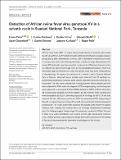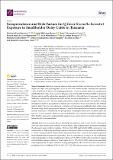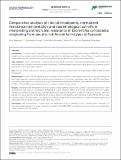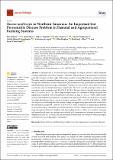Search
Now showing items 71-80 of 91
Detection of African swine fever virus genotype XV in a sylvatic cycle in Saadani National Park, Tanzania
(Wiley Online Library, 2020-07-22)
African swine fever (ASF) is a severe haemorrhagic disease of domestic pigs caused
by ASF virus (ASFV). ASFV is transmitted by soft ticks (Ornithodoros moubata complex
group) and by direct transmission. In Africa, ASF ...
Molecular detection and genetic characterization of Bartonella species from rodents and their associated ectoparasites from northern Tanzania
(PLOS ONE, 2019-10-15)
Background
Bartonellae are intracellular bacteria, which can cause persistent bacteraemia in humans
and a variety of animals. Several rodent-associated Bartonella species are human pathogens but data on their global ...
Influence of fluoride on the prevalence of diabetes mellitus in selected fluoride endemic areas of Tanzania
(International Journal of Biosciences, 2019-11-15)
Diabetes Mellitus prevalence in developing countries and globally is on the increase due to various factors and its
association with excessive fluoride contamination is not much elucidated. This study aims to determine ...
Detection of carrier state and genetic diversity of Theileria parva in ECF-vaccinated and naturally exposed cattle in Tanzania
(Elsevier B.V., 2019-08)
Infection and Treatment Method (ITM) has been practiced in Tanzania for over 20 years as a
prevention measure against East Coast Fever disease. It is known that ITM, like natural ECF
infection, leads to a carrier state, ...
Seroprevalence and Risk Factors for Q fever (Coxiella burnetii) Exposure in Smallholder Dairy Cattle in Tanzania
(MDPI, 2022-11-28)
Q fever is a zoonotic disease, resulting from infection with Coxiella burnetii. Infection in cattle can cause abortion and infertility, however, there is little epidemiological information regarding the disease in dairy ...
Epidemiology of Q-fever in domestic ruminants and humans in Africa. A systematic review
(CABI One Health, 2022-11-17)
Q-fever is a zoonotic infectious disease caused by the gram-negative, intracellular, spore-forming bacterium Coxiella burnetii .
Infected ruminants (cattle, sheep, and goats) are the reservoirs of the pathogen and thus ...
Comparative analysis of clinical breakpoints, normalized resistance interpretation and epidemiological cut-offs in interpreting antimicrobial resistance of Escherichia coli isolates originating from poultry in different farm types in Tanzania
(Microbiology Society, 2014-07-14)
Introduction. Existing breakpoint guidelines are not optimal for interpreting antimicrobial resistance (AMR) data from animal
studies and low-income countries, and therefore their utility for analysing such data is limited. ...
Taenia multiceps in Northern Tanzania: An Important but Preventable Disease Problem in Pastoral and Agropastoral Farming Systems
(MDPI, 2022-08-26)
Coenurosis due to Taenia multiceps has emerged as a major concern to small ruminant-owning communities in northern Tanzania. Although a high incidence of disease has been reported, gaps still remain in our knowledge of the ...
Seroepidemiology of Leptospira serovar Hardjo and associated risk factors in smallholder dairy cattle in Tanzania
(PLOS ONE, 2023-04-05)
Background
Smallholder dairy farming is crucial for the Tanzanian dairy sector which generates income and employment for thousands of families. This is more evident in the northern and southern highland zones where dairy ...
A case-control study on the driving factors of childhood brain volume loss: What pediatricians must explore
(PLOS ONE, 2022-12-30)
Background
The brain volume loss also known as brain atrophy is increasingly observed among children in the course of performing neuroimaging using CT scan and MRI brains. While severe forms of brain volume loss are ...










